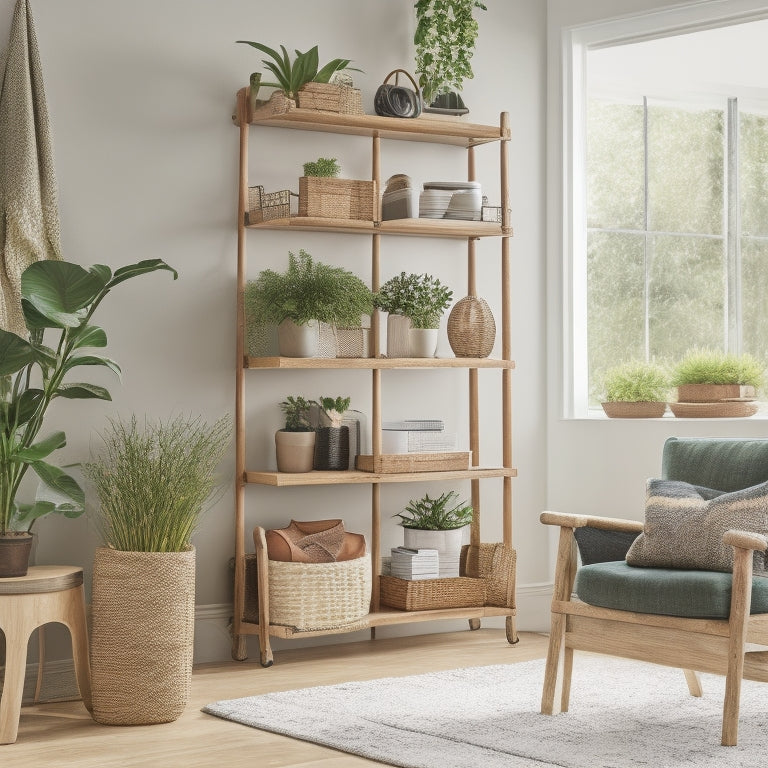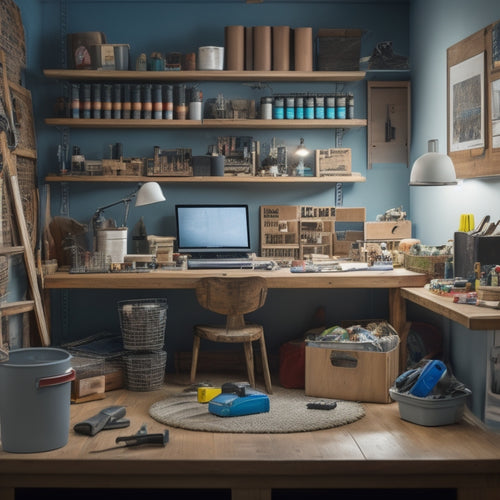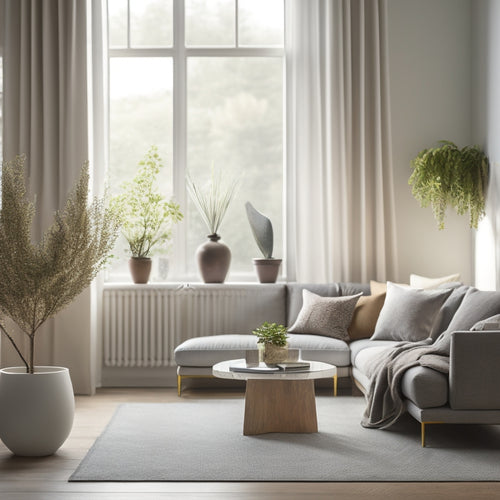
Revolutionize Your Space: DIY Home Storage Hacks
Share
You're about to discover a treasure trove of DIY home storage hacks that will transform your space into a clutter-free oasis, tailored to your unique needs and style. From utilizing digital tools to declutter and visualize your space, to maximizing vertical space with creative shelving and storage solutions, you'll learn how to turn every nook and cranny into a functional haven. Get ready to repurpose old furniture, create customized storage units, and organize with labels and signs. As you explore these DIY hacks, you'll uncover the secrets to a space that's not only organized but also reflects your personal style, and the best part? The possibilities are endless!
Key Takeaways
• Utilize digital organization tools to categorize and track possessions, creating a virtual inventory to identify patterns and duplicates.
• Maximize space with creative storage solutions, such as under-bed containers and hanging organizers, to create a sense of openness.
• Think vertically by using wall-mounted planters, trellises, and DIY shelving ideas to optimize storage and add visual interest.
• Implement a labeling system with color-coding and signs to establish a clear storage system, making it easy to identify and access items.
• Get creative with repurposed vintage furniture, hidden storage solutions, and customized storage containers to solve specific storage problems.
Decluttering With Digital Tools
You can efficiently sort through your belongings and identify items to purge by using digital tools like apps and online platforms that help you categorize, track, and analyze your possessions. These tools empower you to take control of your clutter and make informed decisions about what to keep and what to let go of.
Digital cataloging allows you to create a virtual inventory of your belongings, making it easy to identify patterns, duplicates, and items that no longer serve a purpose. Through virtual decluttering, you can visualize your space and experiment with different layouts and organization systems without having to physically move a single item.
This process helps you develop a clearer understanding of your storage needs and creates a roadmap for a more organized and clutter-free living space. By leveraging digital tools, you can streamline the decluttering process, save time, and achieve a more organized and peaceful living environment.
Storage Hacks for Small Spaces
Maximizing every inch of available space is essential in small homes, where clever storage hacks can mean the difference between cluttered chaos and serene minimalism. You can't afford to waste a single square foot, so think creatively about how to utilize every nook and cranny.
For instance, consider investing in under bed storage containers or bins that slide effortlessly beneath your bed frame, perfect for stashing out-of-season clothing or linens. These creative solutions will help keep your floors and closets clear, creating a sense of openness and airiness in even the tiniest of spaces.
When it comes to small space hacks, DIY projects can be a game-changer. Try repurposing old furniture or crates to create unique storage units that double as decorative pieces. You can also use hanging organizers or shelves to keep items off the floor and out of the way, making your space feel more expansive.
Maximizing Vertical Space Online
Online, vertical space is waiting to be tapped, and a few clever clicks can turn your walls into valuable storage real estate.
You can start by exploring the world of vertical gardening, where you can grow your favorite herbs, succulents, or flowers on a trellis or a wall-mounted planter. This not only adds a touch of greenery to your space but also frees up floor space.
Hanging planters are another great way to maximize vertical space. You can hang them from the ceiling or a hook, adding a decorative element to your room while keeping your plants off the floor.
When choosing the right hanging planter, consider the weight and size of the pot, as well as the type of plant you're using. Make sure the planter is sturdy and securely attached to the wall or ceiling to avoid any accidents.
You can also get creative with DIY projects, like upcycling old pallets or crates into hanging planters. With a little imagination, you can turn your walls into a lush oasis, adding visual interest and functionality to your space.
DIY Shelving Units Made Easy
Building DIY shelving units is a cinch, especially when you repurpose materials like reclaimed wood, crates, or even old bookshelves to create functional storage solutions that add a touch of industrial chic to your space. You can easily create a unique shelving unit that reflects your personal style and complements your home's décor.
For a sleek and modern look, consider installing DIY floating shelves. With easy installation, you can add a touch of sophistication to any room. Plus, you can customize the size and design to fit your specific needs.
Want to add some visual interest? Try incorporating creative shelf designs, such as asymmetrical or geometric shapes, to create a one-of-a-kind storage solution.
The best part? You can customize your shelving unit to fit your specific storage needs. Need more space for books? Add a few extra shelves. Want to display decorative items? Incorporate some open shelving. With DIY shelving units, the possibilities are endless, and the result is a functional and stylish storage solution that's all your own.
Organizing With Labels and Signs
As you tackle your DIY home storage projects, you'll quickly realize the importance of labeling and signing your storage solutions. By doing so, you'll create a visually appealing system that's easy to navigate, ensuring you can quickly find what you need.
In this section, you'll learn how to effectively use labels, signs, and visual reminders to maximize your storage space and maintain organization.
Labeling Storage Containers
Establish a system that makes sense to you and label each storage container with its contents, so you can quickly identify what's inside without having to dig through everything. This simple step can save you time and frustration in the long run.
When labeling, consider using a color-coding system to categorize similar items or rooms. For instance, use blue labels for bedroom storage and green for kitchen items. This visual cue will help you quickly locate the container you need.
Get imaginative with your labeling by using fun fonts, stickers, or even images to make the labels more visually appealing. You can also add a brief description of the contents or the date the container was packed. This will help you keep track of what's inside and make sure you don't forget about items stored away for long periods.
Remember to keep your labels concise and easy to read, so you can quickly glance at the container and know what's inside. By labeling your storage containers thoughtfully, you'll be able to find what you need in a snap, making your life easier and more organized.
Signs for Hidden Spaces
Identify hidden storage areas in your home, such as under-bed compartments or secret shelves, and use signs to mark their contents, ensuring you can easily recall what's stored in these out-of-sight spaces. This clever hack helps you make the most of your concealed storage areas, keeping your belongings organized and easily accessible.
By labeling these secret compartments, you'll avoid the frustration of digging through cluttered areas or forgetting what's stored in them.
Use chalkboard labels, adhesive vinyl, or even decorative wooden signs to create visually appealing markers for your hidden storage areas. You can also repurpose old picture frames or create custom signs with paint or stickers.
The key is to make the signs easy to read and understand, so you can quickly identify what's stored in each area.
Visual Reminders Matter
You'll be amazed at how effectively visual reminders, such as labels and signs, can keep your storage spaces organized and your mind clutter-free. By incorporating color-coded organization, you can create a system that's easy to follow and maintain. For instance, use different colored labels for different categories or tasks, and you'll find yourself quickly identifying what's inside a storage bin or folder.
| Visual Reminder | Benefits |
|---|---|
| Labels | Identify contents at a glance, color-code for categories or tasks |
| Inspirational Quotes | Boost motivation, add a personal touch to your space |
| Signs | Direct attention to important information, create a sense of direction |
| Memory Aids | Help remember important dates, tasks, or routines |
Visual reminders can also serve as memory aids, helping you remember important dates, tasks, or routines. And, why not add some motivational decor to your space? Inspirational quotes can be a great way to boost your mood and energy. By incorporating these visual reminders into your storage spaces, you'll create a system that's both functional and uplifting.
Repurposing Old Furniture Online
Scouring online marketplaces and social media platforms, you can find a treasure trove of old furniture waiting to be repurposed into unique storage solutions for your home. With a little creativity and some TLC, you can transform vintage pieces into functional and stylish storage units.
Consider giving furniture restoration a try, and breathe new life into worn-out pieces. Upcycling projects can be a great source of DIY inspiration, and you'll be amazed at how easily an old dresser can become a storage bench or a vintage ladder can turn into a bookshelf.
When browsing online, look for pieces with good bones, like sturdy frames and quality materials. Don't be deterred by worn finishes or outdated designs – these can be easily updated with a fresh coat of paint or new hardware.
Think outside the box and imagine how each piece can be repurposed to meet your storage needs. With a little creativity and elbow grease, you can create one-of-a-kind storage solutions that not only add functionality to your space but also tell a story.
Utilizing Hidden Storage Spaces
Maximize your home's storage potential by tapping into hidden spaces, such as the area beneath your stairs, inside hollowed-out books, or behind sliding panels, which can be cleverly repurposed to stash away items and keep clutter at bay.
By incorporating secret compartments and camouflaged storage into your home, you'll be amazed at how much more organized and clutter-free your space can become.
Here are a few ideas to get you started:
-
Hollowed-out bookshelves: Remove the pages from old books and use them to store small items like jewelry, keys, or important documents.
-
Sliding panel storage: Install sliding panels in your walls or furniture to create hidden compartments for storing items like linens, toys, or cleaning supplies.
-
Under-stair storage: Use the space beneath your stairs to store items like luggage, out-of-season clothing, or even a hidden desk or workspace.
Creating a Home Inventory System
As you start creating a home inventory system, you'll want to take stock of your belongings and categorize them in a way that makes sense to you. This will help you identify what you have, where it's stored, and what you might need to get rid of.
Organize Your Belongings
By categorizing your belongings and assigning them a designated space, you'll be able to create a thorough home inventory system that helps you quickly locate items and maintain a sense of organization and control. This system will enable you to keep track of what you have, where it's stored, and when you need to restock or replace items.
To get started, sort your belongings into categories, such as 'kitchen items,' 'bedding,' or 'office supplies.' Then, assign a designated space for each category. This can be a shelf, cabinet, or even a specific drawer. Consider implementing a color coding system to differentiate between categories or to indicate the frequency of use.
Here are three ways to enhance your inventory system:
-
Minimalist design: Use simple, unlabeled storage containers to maintain a clean and clutter-free appearance.
-
Use clear storage bins to easily identify contents without having to label them.
-
Designate a 'launching pad' near the entrance of your home where you can place items that need to be returned or put away later.
Track Household Items
You'll now take your organized belongings to the next level by creating a home inventory system that tracks household items, helping you stay on top of maintenance, repairs, and replacements. This system will give you a clear picture of what you own, where it's located, and when it needs attention.
Imagine being able to quickly locate a specific item, or identify which items need to be replaced or serviced.
To create your inventory tracking system, start by categorizing your items into groups, such as kitchen appliances, electronics, or furniture. Assign a unique identifier to each item, and note its item location, condition, and any relevant details, like serial numbers or purchase dates.
You can use a spreadsheet, app, or even a physical notebook to store this information. As you add or remove items, update your system to reflect the changes.
With your inventory tracking system in place, you'll be able to effortlessly manage your household items, saving you time and reducing stress.
Customizing Storage With 3D Models
Custom 3D models can transform your storage spaces into functional works of art that reflect your personal style and needs. With the rise of 3D printing solutions, you can now create customized storage solutions that cater to your specific requirements. Whether you need a unique shelf design or a bespoke storage container, 3D modeling allows you to bring your ideas to life.
Here are three ways you can utilize 3D models to customize your storage spaces:
-
Design for functionality: Create 3D models that maximize storage capacity while minimizing space. For example, you can design a custom shelving unit that fits snugly into a corner or a storage bin with intricate compartments.
-
Add personal flair: Incorporate your personal style into your storage solutions. You can design 3D models with unique shapes, colors, or patterns that reflect your individuality.
-
Solve specific problems: Identify a storage problem in your home and design a 3D model that solves it. For instance, you can create a custom phone holder or a cable organizer that keeps your workspace tidy.
Streamlining Your Closet Space
As you stand in front of your closet, you're likely overwhelmed by the clutter and disorganization. It's time to take control and transform this space into a serene and functional area that makes your daily routine easier.
Maximize Shelf Space
Optimize your closet's vertical space by installing stacked shelves or storage units that go up to the ceiling, effectively doubling or tripling your storage capacity. This will allow you to store more items without taking up valuable floor space.
To take it to the next level, consider these creative shelving solutions:
-
DIY shelf dividers: Create separate compartments for different types of items, such as clothes, shoes, or accessories. This will keep your closet organized and make it easier to find what you need.
-
Utilize under shelf space: Install floating shelves or baskets underneath your existing shelves to store items like bags, hats, or linens. This will maximize the often-wasted space below your shelves.
-
Floating shelf ideas: Use floating shelves to create a visually appealing and functional storage space. You can use them to display decorative items, store books, or even create a mini desk or workspace.
Optimize Closet Organization
With a few strategic tweaks, you can transform your closet from a cluttered catch-all to a serene, functional space that makes your daily routine a breeze. Start by sorting items into categories, such as tops, bottoms, and dresses, and group similar items together.
Next, implement a color-coding system, grouping similar hues together to create a visually pleasing and easy-to-navigate space.
To maximize storage, consider installing hanging shoe organizers on the back of a door or wall. These versatile organizers can store everything from shoes to accessories to bags, keeping them organized and out of the way.
You can also use them to store items like scarves, hats, and belts, keeping them organized and easy to find.
Frequently Asked Questions
Can I Use DIY Storage Hacks for a Rented Space or Apartment?
As you hold the keys to your rented space, think of it as a blank canvas waiting for your creative touch. Yes, you can use DIY storage hacks, focusing on temporary solutions that won't damage the space, to discover space-saving ideas perfect for apartment living.
How Do I Store Items That Are Irregularly Shaped or Oversized?
You'll need creative solutions for storing items with odd shapes. Consider maximizing vertical space by installing shelves or hooks to accommodate bulky items, or use baskets and bins to conceal and organize them.
Are DIY Storage Hacks Suitable for People With Limited Mobility?
You'll find DIY storage hacks can be adapted to accommodate mobility limitations, offering accessible solutions that cater to limited movement. Look for adaptive organization ideas that prioritize ease of use, ensuring independence in your daily routine.
Can I Use DIY Storage Hacks for Outdoor or Garage Storage Needs?
"Think outside the box (literally!) - you can totally repurpose DIY storage hacks for outdoor organization and garage solutions, creating a seamless flow from indoor to outdoor living."
How Do I Ensure DIY Storage Hacks Are Safe for Young Children or Pets?
When creating DIY storage hacks, you'll want to guarantee they're childproofed and pet-friendly by using secure latches, soft edges, and non-toxic materials to prevent accidents and keep your little ones and furry friends safe.
Related Posts
-

What Makes Effective Online DIY Home Organization Courses?
You're about to reveal the secrets to transforming your living space into a serene and functional oasis, and it all b...
-

Streamline Your Space: Decluttering Strategies for Minimalists
You're wasting time and energy maneuvering through cluttered spaces, which is why streamlining your space is essentia...

